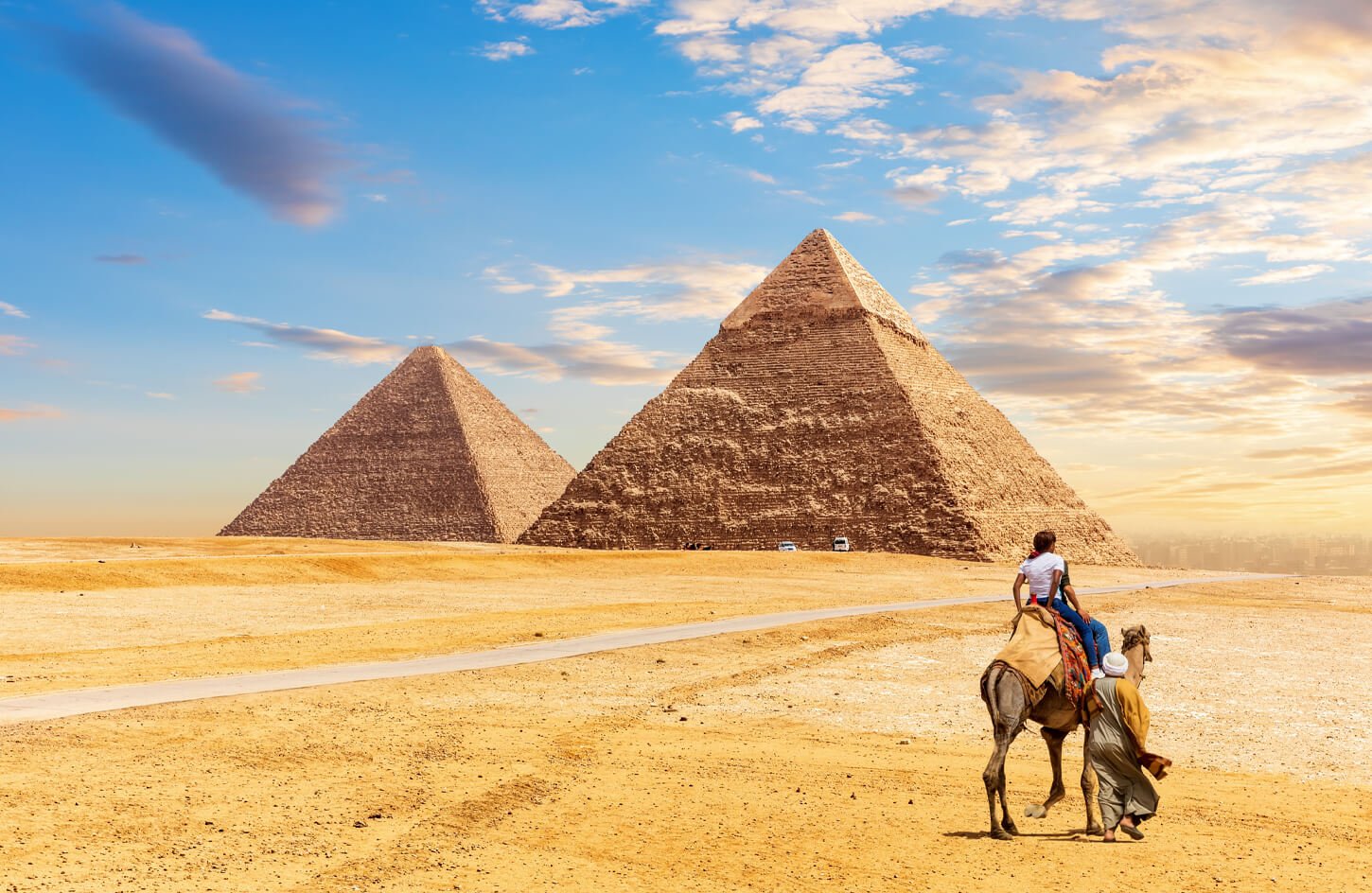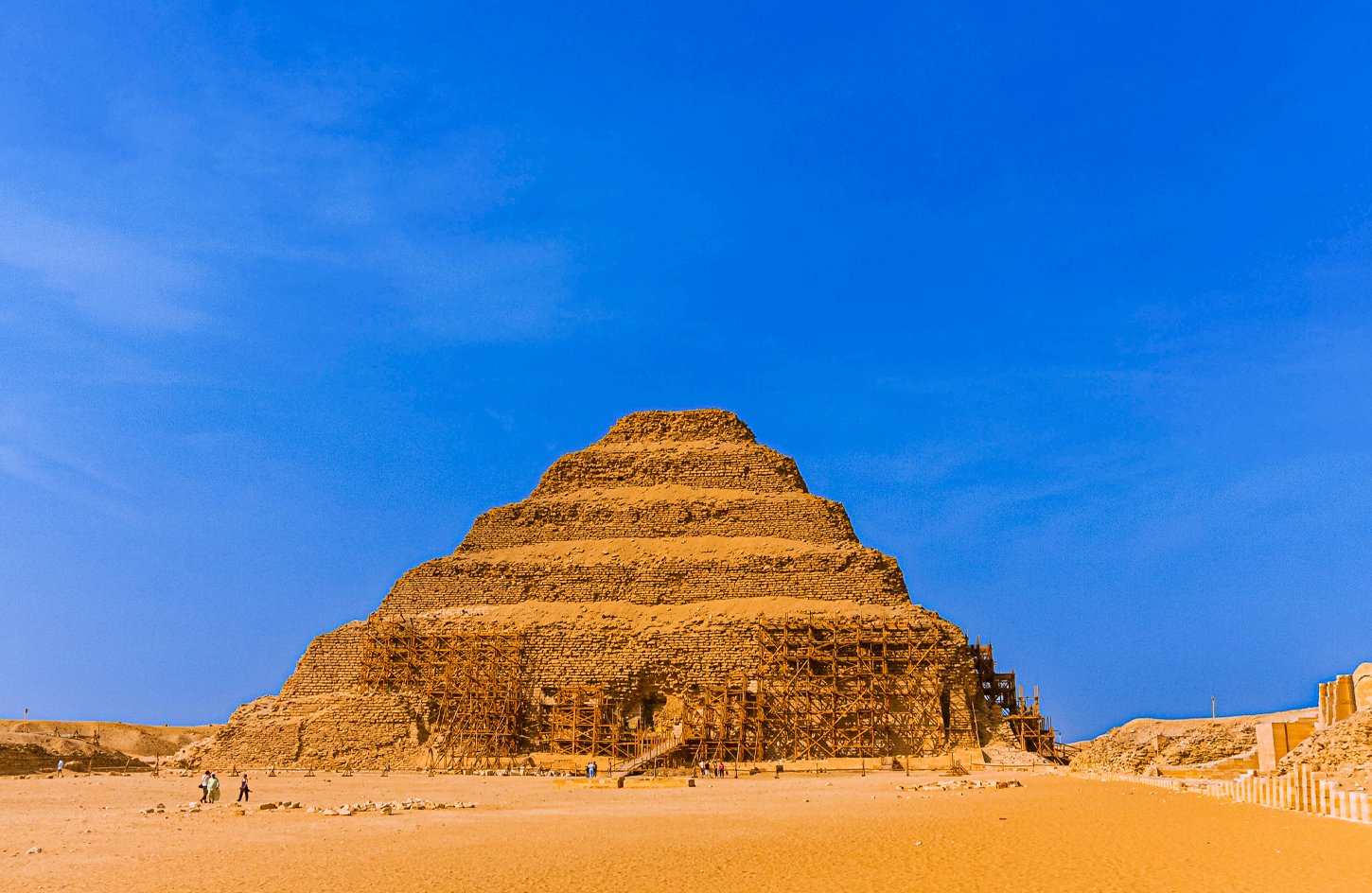Introduction
The Egypt pyramids stand as humanity’s most extraordinary architectural achievements. These UNESCO World Heritage monuments have defied time, weather, and human curiosity for over four millennia. Their precise engineering continues to baffle modern scientists and inspire countless theories.Beyond Giza’s famous trio, Egypt hosts over 100 pyramids across multiple sites. This comprehensive Egypt pyramids guide reveals three essential complexes that showcase pyramid evolution from experimental beginnings to perfected masterpieces.
Saqqara’s Step Pyramid represents humanity’s first monumental stone building. Dahshur’s Bent Pyramid displays architectural trial-and-error in real time. Giza’s Great Pyramid achieves the ultimate expression of ancient engineering genius.
Remarkably, each site offers unique insights into ancient Egyptian civilization, religious beliefs, and construction techniques. Consequently, visiting all three locations provides a complete understanding of pyramid development spanning over 300 years of pharaonic innovation.
Giza Complex: The Ultimate Pyramid Experience

The Giza pyramid complex houses Egypt’s most iconic monuments on the desert plateau just outside Cairo. These three Egypt pyramids represent the pinnacle of ancient Egyptian architectural achievement.
The Great Pyramid of Khufu: Wonder of the Ancient World
Standing 146 meters tall originally, Khufu’s pyramid remained the world’s tallest building for nearly 4,000 years. Its internal air shafts and granite chambers continue revealing secrets through modern technology.
Essential Khufu Experience:
- Interior access: Limited daily tickets require advance booking
- King’s Chamber: Feel temperature drops in the granite sarcophagus chamber
- Grand Gallery: Marvel at 47-meter ascending limestone corridor
- Photo opportunity: Northeast corner offers crowd-free shots
- Skip: Midday summer visits – no shade inside or outside
Archaeologist Tip: Recent electromagnetic scanning revealed hidden chambers above the King’s Chamber. While inaccessible to tourists, these spaces represent ongoing discoveries within this ancient wonder.
Pyramid of Khafre: The Photogenic Giant
Khafre’s pyramid appears taller than Khufu’s due to elevated ground positioning. Its partially preserved casing stones at the apex show how all Egypt pyramids originally gleamed white.
Khafre Highlights:
- Best viewpoint: Frame with the Sphinx for iconic photographs
- Interior visit: Simpler layout than Khufu with impressive burial chamber
- Casing stones: Original limestone covering visible at pyramid’s peak
- Sphinx connection: Same pharaoh commissioned both monuments
Pyramid of Menkaure: The Intimate Wonder
The smallest Giza pyramid offers the most intimate ancient experience. Its manageable size and fewer crowds create contemplative exploration opportunities.
Menkaure Features:
- Easier access: Less crowded interior chambers
- Granite base: Lower courses use expensive Aswan granite
- Queen’s pyramids: Three small pyramids for royal wives
- Unfinished details: Shows construction techniques clearly
The Great Sphinx: Giza’s Guardian
This limestone colossus guards the complex with its human head and lion body. Meanwhile, recent discoveries reveal hidden chambers beneath this ancient monument.
Sphinx Insights:
- Best viewing: Early morning or late afternoon light
- Hidden chambers: Ground-penetrating radar found underground rooms
- Restoration work: Ongoing conservation protects weathered limestone
- Photo angles: Side profile captures most dramatic features
Dahshur: Pyramid Experimentation Ground

Located 40 kilometers south of Cairo, Dahshur showcases pyramid development’s experimental phase. This military-controlled area requires special permits but rewards visitors with uncrowded ancient wonders.
The Bent Pyramid: Architectural Evolution in Stone
This unique structure displays ancient engineering challenges in real time. Builders changed the pyramid’s angle mid-construction, creating its distinctive “bent” profile that gives the monument its modern name.
Bent Pyramid Discoveries:
- Angle change: Shifts from 54° to 43° halfway up
- Structural innovation: Earliest example of smooth-sided pyramid design
- Interior access: Recently opened chambers reveal construction techniques
- Preservation state: Best-preserved pyramid exterior in Egypt
- Color variations: Original limestone casing shows ancient building methods
Archaeologist Tip: The Bent Pyramid’s interior chambers contain the world’s oldest corbelled ceilings. These architectural features demonstrate the transition from step pyramid to smooth-sided design.
The Red Pyramid: First Successful Smooth-Sided Wonder
Egypt’s first successfully completed smooth-sided pyramid earned its name from reddish limestone blocks. Consequently, this monument represents a crucial step toward Giza’s architectural perfection.
Red Pyramid Experience:
- Interior climb: 125-step entrance leads to three internal chambers
- Temperature contrast: Cool interior provides relief from desert heat
- Acoustic properties: Chambers produce remarkable sound effects
- Visitor access: Generally less crowded than Giza monuments
- Construction evidence: Tool marks and builder inscriptions visible
Dahshur Access and Logistics
This protected military zone requires advance planning and proper documentation for visits.
Visiting Dahshur:
- Permit requirements: Tour operators handle military clearances
- Best timing: Morning visits avoid afternoon heat and crowds
- Photography rules: No photos of military installations nearby
- Transport options: Private vehicles only – no public transport access
Saqqara: Where Pyramid History Began

Saqqara’s Step Pyramid revolutionized architecture 4,700 years ago. This UNESCO site continues yielding remarkable discoveries through ongoing archaeological excavations across its vast necropolis.
Step Pyramid of Djoser: The World’s First Monumental Stone Building
Architect Imhotep designed this revolutionary structure by stacking six mastabas vertically. Remarkably, this innovation launched pyramid construction across ancient Egypt for the next millennium.
Step Pyramid Marvels:
- Architectural first: Oldest carved stone columns in history
- Complex design: Surrounded by ceremonial courts and buildings
- Underground network: Extensive tunnels and chambers below ground
- Recent discoveries: 2023 excavations uncovered 30+ mummification jars
- Imhotep’s genius: Later deified for architectural innovations
Archaeologist Tip: The Step Pyramid’s underground galleries stretch for kilometers. Recent laser scanning revealed previously unknown chambers that may contain additional burial goods.
Recent Archaeological Breakthroughs
Saqqara continues producing headline-grabbing discoveries that reshape understanding of ancient Egyptian civilization.
Latest 2023-2024 Discoveries:
- Hidden corridor: Ground-penetrating radar revealed sealed passages
- Mummification workshop: Complete ancient embalming facility uncovered
- Golden mummies: Beautifully preserved remains with intricate wrappings
- Hieroglyphic texts: New inscriptions provide historical insights
- Wooden artifacts: Perfectly preserved furniture and ceremonial items
Saqqara Exploration Strategy
This massive archaeological site requires strategic planning to maximize discoveries while managing time and energy effectively.
Optimal Saqqara Visit:
- Early arrival: Dawn visits avoid tour bus crowds
- Licensed guides: Site guides provide exclusive access to restricted areas
- Comfortable shoes: Extensive walking across sandy terrain required
- Hydration essential: Limited shade across the desert necropolis
- Skip if claustrophobic: Underground Serapeum has narrow passages
Imhotep Museum: Understanding Pyramid Evolution
This on-site museum explains how pyramid design evolved from Saqqara’s experiments to Giza’s perfection.
Museum Highlights:
- Interactive displays: 3D models show construction techniques
- Artifact collections: Tools and materials used by ancient builders
- Imhotep exhibits: Life and achievements of history’s first named architect
- Pyramid timeline: Visual journey from mastaba to smooth-sided monument
Memphis: The Forgotten Capital
Ancient Egypt’s capital city complements any Saqqara visit with colossal statues and historical context about pyramid builders’ civilization.
Memphis Museum Features:
- Ramesses II colossus: Massive limestone statue lying horizontally
- Sphinx of Alabaster: Beautifully carved monument rival
- Historical context: Capital city during pyramid-building era
- Quick visit: 30-minute tour pairs perfectly with Saqqara
Conclusion
Egypt’s pyramid journey spans from Saqqara’s experimental Step Pyramid through Dahshur’s architectural trials to Giza’s perfected monuments. This evolution showcases human ingenuity developing over centuries of royal ambition and engineering innovation. Each site reveals different aspects of ancient Egyptian civilization – from religious beliefs to construction techniques.
Ongoing excavations continue uncovering new chambers, artifacts, and insights about these ancient wonders. Meanwhile, modern technology reveals secrets hidden for millennia within limestone blocks and underground passages. Recent discoveries at Saqqara and hidden chambers detected at Giza prove these monuments still hold countless mysteries.
The pyramid experience extends far beyond photography and tourist visits. These monuments represent humanity’s earliest architectural achievements and continue inspiring modern engineers and archaeologists through their sophisticated design and construction methods.
Ready to explore these ancient engineering marvels with expert guidance? Book our Pyramidologist-Guided Tour for exclusive access to restricted chambers and ongoing excavation sites.
Check out our other articles:

